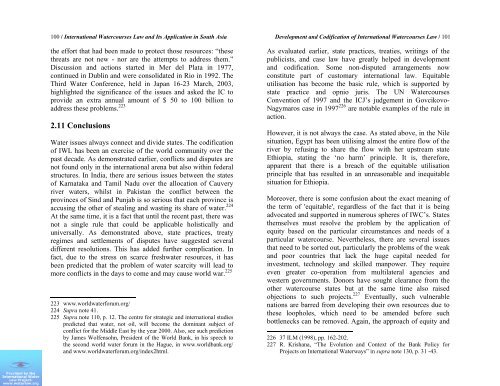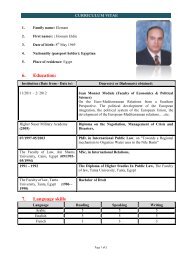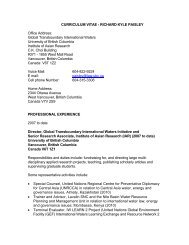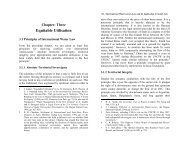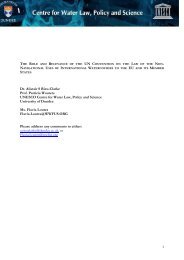Upreti, Trilochan, International Watercourses Law and Its Application ...
Upreti, Trilochan, International Watercourses Law and Its Application ...
Upreti, Trilochan, International Watercourses Law and Its Application ...
You also want an ePaper? Increase the reach of your titles
YUMPU automatically turns print PDFs into web optimized ePapers that Google loves.
100 / <strong>International</strong> <strong>Watercourses</strong> <strong>Law</strong> <strong>and</strong> <strong>Its</strong> <strong>Application</strong> in South Asia Development <strong>and</strong> Codification of <strong>International</strong> <strong>Watercourses</strong> <strong>Law</strong> / 101the effort that had been made to protect those resources: “thesethreats are not new - nor are the attempts to address them.”Discussion <strong>and</strong> actions started in Mer del Plata in 1977,continued in Dublin <strong>and</strong> were consolidated in Rio in 1992. TheThird Water Conference, held in Japan 16-23 March, 2003,highlighted the significance of the issues <strong>and</strong> asked the IC toprovide an extra annual amount of $ 50 to 100 billion toaddress these problems. 2232.11 ConclusionsWater issues always connect <strong>and</strong> divide states. The codificationof IWL has been an exercise of the world community over thepast decade. As demonstrated earlier, conflicts <strong>and</strong> disputes arenot found only in the international arena but also within federalstructures. In India, there are serious issues between the statesof Karnataka <strong>and</strong> Tamil Nadu over the allocation of Cauveryriver waters, whilst in Pakistan the conflict between theprovinces of Sind <strong>and</strong> Punjab is so serious that each province isaccusing the other of stealing <strong>and</strong> wasting its share of water. 224At the same time, it is a fact that until the recent past, there wasnot a single rule that could be applicable holistically <strong>and</strong>universally. As demonstrated above, state practices, treatyregimes <strong>and</strong> settlements of disputes have suggested severaldifferent resolutions. This has added further complication. Infact, due to the stress on scarce freshwater resources, it hasbeen predicted that the problem of water scarcity will lead tomore conflicts in the days to come <strong>and</strong> may cause world war. 225223 www.worldwaterforum.org/224 Supra note 41.225 Supra note 110, p. 12. The centre for strategic <strong>and</strong> international studiespredicted that water, not oil, will become the dominant subject ofconflict for the Middle East by the year 2000. Also, see such predictionby James Wolfensohn, President of the World Bank, in his speech tothe second world water forum in the Hague, in www.worldbank.org/<strong>and</strong> www.worldwaterforum.org/index2html.As evaluated earlier, state practices, treaties, writings of thepublicists, <strong>and</strong> case law have greatly helped in development<strong>and</strong> codification. Some non-disputed arrangements nowconstitute part of customary international law. Equitableutilisation has become the basic rule, which is supported bystate practice <strong>and</strong> opnio juris. The UN <strong>Watercourses</strong>Convention of 1997 <strong>and</strong> the ICJ’s judgement in Govcikovo-Nagymaros case in 1997 226 are notable examples of the rule inaction.However, it is not always the case. As stated above, in the Nilesituation, Egypt has been utilising almost the entire flow of theriver by refusing to share the flow with her upstream stateEthiopia, stating the ‘no harm’ principle. It is, therefore,apparent that there is a breach of the equitable utilisationprinciple that has resulted in an unreasonable <strong>and</strong> inequitablesituation for Ethiopia.Moreover, there is some confusion about the exact meaning ofthe term of 'equitable', regardless of the fact that it is beingadvocated <strong>and</strong> supported in numerous spheres of IWC’s. Statesthemselves must resolve the problem by the application ofequity based on the particular circumstances <strong>and</strong> needs of aparticular watercourse. Nevertheless, there are several issuesthat need to be sorted out, particularly the problems of the weak<strong>and</strong> poor countries that lack the huge capital needed forinvestment, technology <strong>and</strong> skilled manpower. They requireeven greater co-operation from multilateral agencies <strong>and</strong>western governments. Donors have sought clearance from theother watercourse states but at the same time also raisedobjections to such projects. 227 Eventually, such vulnerablenations are barred from developing their own resources due tothese loopholes, which need to be amended before suchbottlenecks can be removed. Again, the approach of equity <strong>and</strong>226 37 ILM (1998), pp. 162-202.227 R. Krishana, “The Evolution <strong>and</strong> Context of the Bank Policy forProjects on <strong>International</strong> Waterways” in supra note 130, p. 31 -43.


